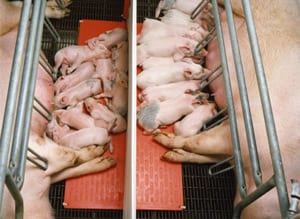
Two methods for keeping pigs warm – pig heating pads and heat lamps – are commonly used in pig farming to keep animals warm, with each method having advantages and disadvantages. For young pigs, the type of heating and where it’s placed greatly affect the animal’s health, along with how quickly the pigs grow. Creating properly-heated microenvironments for piglets during farrowing, nursing and weaning will accelerate their time to market while helping to reduce health issues like scours, especially prior to weaning, while generally keeping livestock healthier and more comfortable.
Comparing Pig Heating Pads to Heat Lamps
The key difference between pig heating pads and heat lamps is the position where they are installed. Heat lamps are positioned above animals and project heat down from above, while pig heating mats provide under-body heat. For farrowing and nursing animals, farmers typically use one or the other method for creating a heated microclimate, but for some critical times of a pig’s life – like day one – producers use both.
Traditional Heat Lamps for Pigs
Used for decades in animal farming applications, heat lamps normally feature metal or plastic covers that deflect heat downward, along with guards around the bulbs to reduce breakage. Countless companies supply heat lamps, so they are generally easy to obtain and can quickly provide a heat source when needed. Heat lamps are also easier to reposition or move from pen to pen.
As lamps are suspended above pens, a certain proportion of their heat escapes upwards, and also dissipates some before reaching the animal zone. Along with their relatively narrow heating area and higher wattages than heat mats, they are much less efficient. Lamps must be positioned high enough so as to accommodate large numbers of animals, but close enough to provide ample heat. As heat bulbs are quite fragile, using them creates a risk of injury or shock to animals and caretakers should the bulbs break.
Pros
- Easily moved and repurposed.
- Relatively inexpensive initial investment.
- Simple to use.
- Widely available.
Cons
- Glass breakage can cause injury or expose animals and workers to electrical shock danger.
- Heat lamps must be raised to provide larger coverage area, which reduces intensity, whereas they must be lowered to increase intensity, decreasing the area covered.
- Highly inefficient.
- Lamps burn out with some frequency, which can cause loss of heat for several hours if not replaced right away.
- May burn piglets if positioned too low.
- Often bulbs last only days.
- Ongoing replacement cost for bulbs.
- Provides heat to only a small, localized area.
Pig Heating Pads
Studies have shown piglets three weeks and younger generally grow better with pig heating pads. The manner in which pads fit into the creep area creates a natural gap between piglets and a sow, helping to reduce mortality. Pig heating mats are also much more reliable, ensuring young animals always have heat where it is needed but allowing room temperatures to remain cool and more comfortable for sows and other older animals. This has the added benefit of reducing losses from crushing, as overheated sows tend to become restless, sometimes crushing their offspring.
Pros
- Allows a larger heated area exactly where it is needed.
- Creates a gap between the heat source and sow, helping prevent losses from crushing.
- Fits square or rectangular geometry of farrowing stalls and nursery pens.
- One double mat can serve two crates or pens.
- Keeps sows cooler, encouraging them to eat and lactate more.
- Placed directly underneath young pigs for more efficient heating.
- When properly maintained and secured, heating pads for pigs can last decades.
- Provides even, consistent temperatures across the entire mat’s surface.
- Saves electricity when compared to heat lamps.
- Temperature is more easily regulated, especially when used with a control.
Cons
- More expensive initial investment.
Stanfield® Pig Heating Pad
Osborne’s Stanfield pig heating pads help pig farmers maintain safe and comfortable microclimates for their livestock. They also maximize energy efficiency, using as little as a third of the electricity of heat lamps. Stanfield pig heating mats for farrowing operate from about 30-35° F (16-20° C) above room temperature, while those designed for nurseries and larger animals provide temperatures of 20-25° F (11-14° C) above room temperature. These heating pads also provide a warm area on which piglets can rest, keeping them away from nursing sows to help prevent losses from crushing.
Composed of a tough fiberglass-reinforced composite, Stanfield pig heating pads are durable and easily cleaned. They also help to block drafts from below and provide piglets with a solid surface on which to stand. The fire-retardant and water-resistant materials from which these pig heating pads are made additionally create a safer environment in which piglets can grow. Through the use of controllers, the heat they put out can also be decreased as pigs grow, lowering energy costs further.
To learn more about our heating pads for pigs and other livestock equipment, please contact us today!



